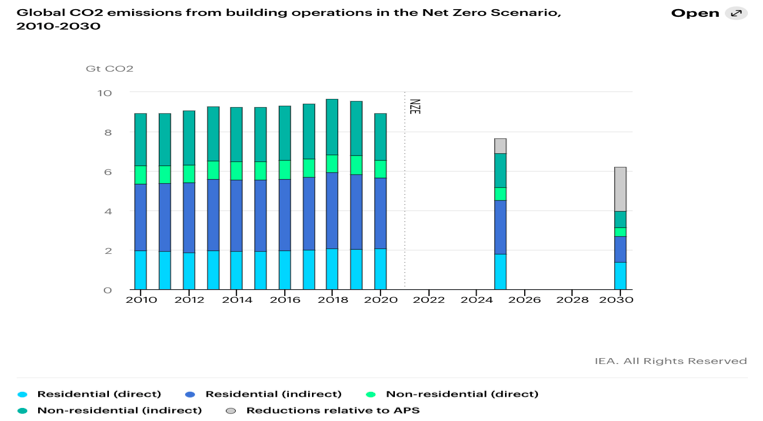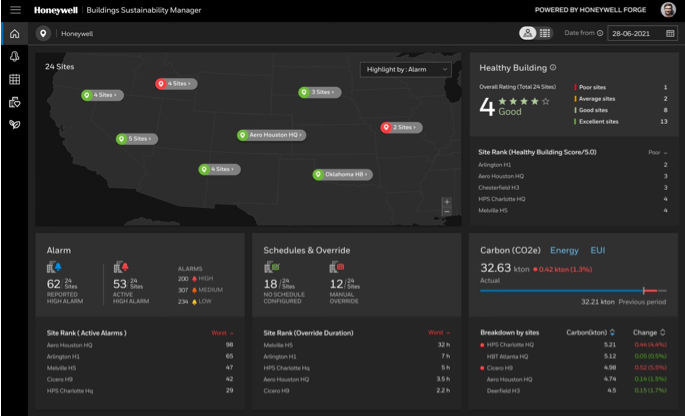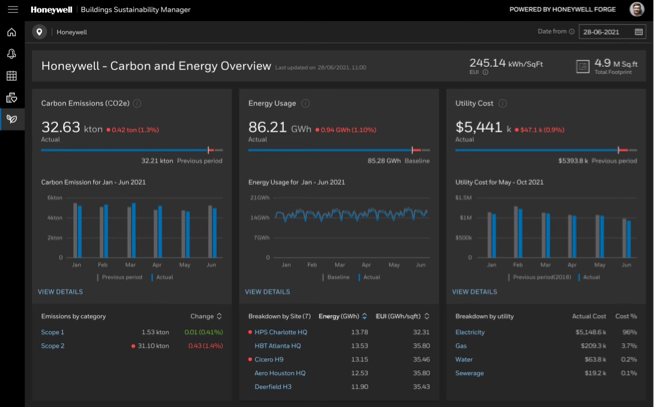
The News: Honeywell unveiled its new Carbon & Energy Management Software this week, designed to be the centerpiece of the company’s Sustainable Buildings Portfolio. See the full Press Release from Honeywell here.
Honeywell’s Carbon & Energy Management Software Shines in the Company’s Sustainable Buildings Solutions Portfolio
Analyst Take: I’ve had the pleasure of attending Honeywell’s User Group (HUG) Symposium in Phoenix this week, a three-day event for customers by customers, designed for sharing information, ideas, and experiences with industry peers. At HUG, sustainable buildings and discussion around customer challenges as it relates to sustainability initiatives has largely been the focal point of all discussions. And understandably so — reducing the environmental impact of buildings and keeping employees safe are on everyone’s minds these days, as is the enormous challenge of meeting corporate sustainability goals related to carbon neutrality.
Without exception, every Honeywell customer and partner I’ve spoken with or heard from in a keynote or panel discussion these last few days has shared the enormity of this challenge. And of course, it’s not unique to Honeywell customers and partners — it’s an industry-wide issue that organizations in every industry and vertical all over the world are grappling with.
Some food for thought: commercial buildings account for one-third of global energy consumption and 37% of global energy CO2 emissions — and 28% of those emissions are specifically related to building operations. Although a small amount of progress has been made, and the pandemic and a pivot to work from home drastically changed building energy consumption for a time, data from the IEA indicates that unless significant change happens, buildings are not currently on track to achieve carbon neutrality by 2050. Change must happen — and quickly. Here’s a look at some data from IEA on carbon emissions from buildings —

Image and resource credit: IEA
In order to meet 2050 carbon neutrality goals, IEA estimates that all new buildings and 20% of the existing buildings in the world would need to be zero-carbon-ready by or before 2030. Curbing energy consumption, reducing carbon emissions, creating more sustainable facilities (that are also healthier for employees and workers) are urgent concerns and it’s safe to say that everyone feels that clock ticking. Eight years is not a long time, not by any stretch.
The challenge, for most organizations, is that they don’t yet have the ability to both understand the energy they are consuming and/or the ability to control it. That’s where Honeywell’s newly unveiled Carbon & Energy Management Software, now available globally, comes in. It’s a much-needed solution, from a long-trusted partner in building and facilities management, for building owners who need better, more complete, actionable data about their facilities and operations. The timing around this product launch couldn’t be better.
Honeywell’s Carbon & Energy Management Software
Honeywell’s Carbon & Energy Management Software is a cloud-based service available as part of the Honeywell Forge platform for data, analytics, and IoT capabilities. Forge is an enterprise performance management solution utilized for operational digital transformation, designed to use operational data to help improve processes, empower workers, enhance productivity, and support sustainability initiatives.
The system leverages artificial intelligence (AI) and machine learning (ML) and provides insight by way of sensor data, smart meters, and utility data, showing usage in real time. The software solution can alert facilities managers to problem areas across their entire portfolio of building locations, track individual pieces of building equipment, provide rankings like “Healthy Building Scores,” and provide data on energy usage and carbon footprint broken down by site — all by way of a dashboard that is designed to easily break down data into KPIs that allow quick and easy ingestion of information and can help provide a roadmap for action for building owners and facilities managers. Here’s a look at the platform dashboard:

Image source: Honeywell
The software monitors and ranks sites, shows CO2 usage, ranks buildings on a health scale, and allows users to dive into the details on a site-specific basis at any time.
The platform also offers up real time data on energy usage and costs and tracks emissions. The Honeywell customers I’ve had the opportunity to talk with these last few days are excited about the integration of this Carbon & Energy Management platform into the Forge platform and all agree it will provide a much-needed assist. You can’t fix what you can’t monitor and, as it relates to gathering the data needed to develop strategies around meeting sustainability goals and putting those strategies in action, this platform delivers in a big way. Here’s a look at the dashboard that allows the monitoring of energy use, costs, et al., on a per facility basis — and users can also dive more deeply into the data per facility as desired.

Image source: Honeywell
Sustainability Initiatives Will Only Continue to Grow
Why is this such a timely offering? Sustainability is on everyone’s minds today, and with good reason: taking action and embracing sustainability initiatives is an urgent global concern. Organizations across the globe are making public sustainability promises that they’ll be held accountable for by stakeholders — including business leaders, employees, prospective employees, customers, community leaders, and the investment community — yet they are largely operating in the dark.
While we’ve got massive amounts of data, the vast majority of that data is not yet being harnessed or utilized in any effective manner — and that’s the problem this solution from Honeywell solves. The as-a-a-service offering continuously monitors, assesses, analyzes, and can optimize building performance, measuring sustainability down to a device or asset level.
There are myriad applications here, all designed to help the CRE industry as a whole, facilities managers, and even corporate leaders ensure they have the data they need, and a way to track, measure, and report their progress in meeting energy efficiency goals. Access to this kind of data can also help change the way buildings are utilized — how they are heated and cooled based on occupancy and usage and more — and allow for the continuous improvement of performance based on real time insights from data.
Last but never least, access to data from Honeywell’s Carbon & Energy Management Software is designed to monitor the health of environments of buildings, which allows organizations to provide safe, healthy, and sustainable work environments for their employees. While five years ago, this might not have been something employees took into consideration when considering a job offer and/or deciding to stay with an employer, a global pandemic heightened awareness around the safety of work environments. That, combined with a very real desire on the part of employees to work with and for companies who care about sustainability and who are actively working toward meeting net carbon zero goals make this a very important part of the talent recruitment/talent retention and overall workplace culture equation.
Sustainability is absolutely becoming the new competitive advantage. Whether its increasing the value of commercial real estate, satisfying investor and other stakeholder concerns around sustainability, improving the health of buildings, improving throughput for retail warehouses, impacting and improving product quality, improving profitability of retail operations, boosting efficiencies in operations, or providing attractive, safe workplaces that employees are excited about being in, sustainability is the name of the game. Solutions like Honeywell’s Carbon & Energy Management Software are designed to help organizations get where they need to be. It will be exciting to watch this play out and see which organizations really get the importance of sustainability initiatives, and the technology solutions they use to get to help them reach their sustainability goals.
Disclosure: Futurum Research is a research and advisory firm that engages or has engaged in research, analysis, and advisory services with many technology companies, including those mentioned in this article. The author does not hold any equity positions with any company mentioned in this article.
Analysis and opinions expressed herein are specific to the analyst individually and data and other information that might have been provided for validation, not those of Futurum Research as a whole.
Other insights from Futurum Research:
Honeywell’s Carbon Neutrality Initiative to Customers is an Attractive, Timely Offering
Honeywell Brings the Future of Urban and Advanced Aerial Mobility in Focus
Image Credit: Honeywell
The original version of this article was first published on Futurum Research.
Shelly Kramer is a Principal Analyst and Founding Partner at Futurum Research. A serial entrepreneur with a technology centric focus, she has worked alongside some of the world’s largest brands to embrace disruption and spur innovation, understand and address the realities of the connected customer, and help navigate the process of digital transformation. She brings 20 years' experience as a brand strategist to her work at Futurum, and has deep experience helping global companies with marketing challenges, GTM strategies, messaging development, and driving strategy and digital transformation for B2B brands across multiple verticals. Shelly's coverage areas include Collaboration/CX/SaaS, platforms, ESG, and Cybersecurity, as well as topics and trends related to the Future of Work, the transformation of the workplace and how people and technology are driving that transformation. A transplanted New Yorker, she has learned to love life in the Midwest, and has firsthand experience that some of the most innovative minds and most successful companies in the world also happen to live in “flyover country.”

